2023 education highlights: Keeping up the momentum to transform learning
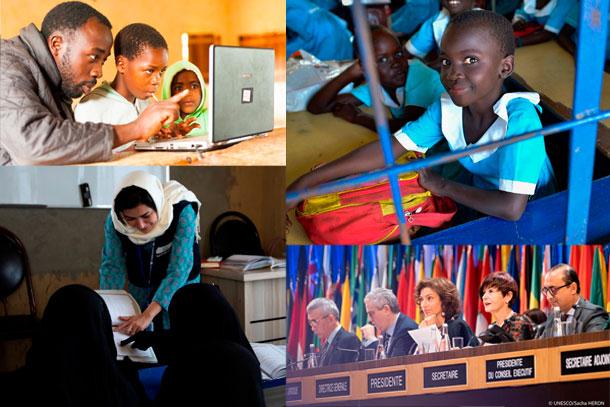

International Day of Education 2023 dedicated to Afghan girls and women
UNESCO dedicated this year's International Day of Education on 24 January to girls and women in Afghanistan who have been deprived of their right to pursue secondary and higher education. The Organization renewed its call to immediately restore their fundamental right to education. “No country in the world should bar women and girls from receiving an education,” said UNESCO Director-General Audrey Azoulay. “The international community has the responsibility to ensure that the rights of Afghan girls and women are restored without delay. The war against women must stop.”
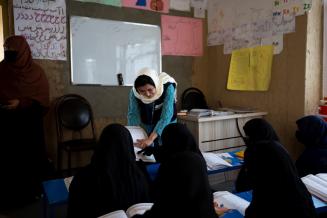
In Afghanistan’s Logar province, most girls and women are illiterate. Even before the decision of the de-facto authorities to suspend girls’ access to beyond primary education, most families did not let their girls go to school. Today, over 1,000 women and young girls aged 15 to 45 are learning how to read, write and calculate for the first time in their lives through UNESCO’s Community-based Basic General Literacy Classes. During UNESCO’s visit to two literacy classes , women and girls shared their motivations, challenges and inspirations for attending the classes. Nationwide, the Organization is currently reaching over 40,000 illiterate and semi-literate youth and adults – over 60% of whom are women – in 20 provinces.
Supporting learners and teachers in Ukraine
UNESCO and Ukraine’s Ministry of Education and Science launched an online training in digital pedagogy for 50,000 teachers, while the education of many Ukrainian students is still disrupted by the war. They are also training 15,000 school psychologists to withstand the impact of the war on the mental health of Ukrainian learners and teachers. “Since February 2022, UNESCO has continuously supported Ukrainian teachers to ensure that students continue learning in the midst of war,” said UNESCO Assistant Director-General for Education Stefania Giannini. “I pay tribute to their work, resilience and continued dedication. As the new academic year has just begun, UNESCO reaffirms its commitment to them. Because education is the cornerstone on which Ukraine's future is built.” Read more

Monitoring country commitments made at the Transforming Education Summit
The latest UNESCO data shows that the global number of out-of-school children has risen by 6 million since 2021 and now totals 250 million. The figures, compiled by the Global Education Monitoring Report and the UNESCO Institute for Statistics, reveal that education progress continues to stagnate globally. The annual finance gap for helping low and lower-middle income countries achieve their national education targets is almost US $100 billion. UNESCO remains committed to supporting countries and partners to acquire the financing needed to meet their goals. The Organization is also monitoring country commitments made at the UN Transforming Education Summit in 2022 through its new dashboard . Read more

Urgent call for appropriate use of technology in learning and global guidance on generative AI in education
UNESCO’s 2023 Global Education Monitoring Report on technology in education highlights the lack of appropriate governance and regulation. It urges countries to set their own terms for the way technology is designed and used in education so that it never replaces in-person, teacher-led instruction, and supports the shared objective of quality education for all. The report proposes four questions that policy-makers and educational stakeholders should reflect upon as technology is being deployed in education. Read more

Generative artificial intelligence (GenAI) tools have far-reaching implications for education and research. Yet the education sector today is largely unprepared for the ethical and pedagogical integration of these powerful and rapidly evolving technologies, as UNESCO Assistant Director-General Stefania Giannini reiterated in her think piece . UNESCO developed the first-ever global guidance on GenAI in education. Launched during UNESCO’s flagship Digital Learning Week , it calls on countries to quickly implement appropriate regulations, policies, and human capacity development, for ensuring a human-centred vision of GenAI for education and research. Read more
UNESCO calls for an upgrade of teachers’ status to reduce the global shortage
“We must better value, better train and better support,” said UNESCO Director-General Audrey Azoulay on World Teachers’ Day (5 October). UNESCO and the Teacher Task Force’s first global report shows that globally, 44 million teachers are still needed to achieve the goal of providing primary and secondary education for all by 2030. This includes a demand for seven out of ten teachers at the secondary level and a need to replace over half of the existing teachers leaving the profession. The problem is not only one of funding, but also the unattractiveness of the profession. Read more

UNESCO adopts landmark guidance on education’s cross-cutting role in promoting peace
On 20 November 2023, the 194 UNESCO Member States adopted the Recommendation on Education for Peace, Human Rights and Sustainable Development at UNESCO’s General Conference . This is the only global standard-setting instrument that lays out how education should be used to bring about lasting peace and foster human development through 14 guiding principles. For the past two years, UNESCO has been revising this visionary tool to ensure it responds to today's greatest challenges and future shocks. Read more

UNESCO at COP28: Making education the long-term solution to the climate crisis
UNESCO is accelerating climate change education and greening initiatives through its coordinating role of the Greening Education Partnership and extensive work on education for sustainable development . At COP28, UNESCO played a key role in the various dialogues on accelerating climate change education and emphasized the significance of sustainable learning in fostering long-term solutions for the climate crisis. The Organization presented at the COP the drafts of two new normative and groundbreaking resources: A global curriculum guidance for climate change education; and a green schools quality standards, which will be finalized and rolled-out next year. A major highlight of the gathering was launch of the Declaration for Climate Change and Education , focused on adaptation, mitigation and investment – which was signed and endorsed by 41 countries. Read more

Exploring how rights should adapt as education evolves
The world has considerably changed since the key treaties on the right to education were conceived and adopted over half a century ago. Education can no longer be only confined to traditional classrooms and textbooks but has expanded to encompass lifelong and life-wide learning. UNESCO's Initiative on the evolving right to education launched its formal dialogue in December to explore how international human rights instruments can be reinforced and further developed to address today's needs and challenges. Read more
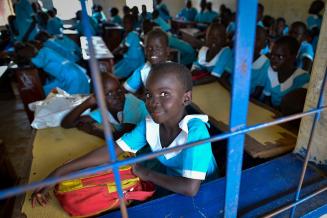
Looking into 2024, the International Day of Education will be celebrated on 24 January under the theme “learning for lasting peace”. The world is seeing a surge of violent conflicts paralleled by an alarming rise of discrimination, racism, xenophobia, and hate speech. An active commitment to peace is more urgent today than ever: Education is central to this endeavor, as underlined by the UNESCO Recommendation on Education for Peace, Human Rights and Sustainable Development .
Key UNESCO publications on education in 2023
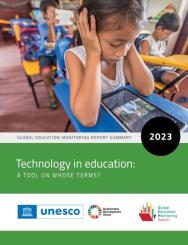
- Greek (modern)
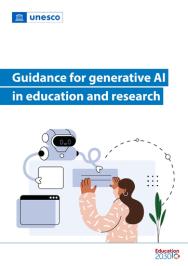
Related items
- Topics: Display
Other recent news


5 of the biggest education trends in 2023
As new education trends lead to innovative teaching and learning, here are some of the top trends to look for.
With the start of a new year and education conference season just beginning, educators and industry leaders are discovering the biggest education trends for 2023. The past few years have seen a significant transformation for education and edtech, and 2023 will continue to bring new ideas and emerging technologies.
This year, schools are placing a focus on supporting students’ individual needs and recovering pandemic learning loss. Because of this, we will see an increase in edtech to support learning, better accommodations for students, a focus on wellbeing, and new approaches to teaching that engage with students’ interests and future careers.
Here are five of the biggest education trends for 2023:
1. Social and Emotional Wellbeing
The pandemic prompted the need for a stronger focus on supporting the social and emotional wellbeing of students and teachers alike. As we rebound from the academic, emotional, and community challenges that arose during the pandemic, schools will need to ensure they’re offering the support and resources that students and teachers need.
Children and teens are currently experiencing higher rates of depression , anxiety, and suicidal thoughts than before the pandemic, and the academic and emotional pressures that come with recovering pandemic learning loss continue to affect student wellbeing. In 2023, we will see schools working to improve mental health programs, provide new academic support systems and resources for students, and implement technologies and programs focused on social-emotional learning and student wellbeing.
Teachers are struggling too: The demands of teaching have led to high rates of teacher stress and anxiety, and K-12 educators have the highest burnout rate of any profession in the U.S. To support teacher wellbeing and retain valuable, talented educators, schools will embrace new ways improve teachers’ work-life balance and wellbeing, including implementing new edtech tools, offering mental health resources, or even redesigning school spaces to better support educators in the classroom.
2. Personalized and Self-Led Learning
Personalized learning is by no means a new education trend, but learning models focused on an individualized or personalized approach will continue to evolve in 2023. Learning gaps widened during the pandemic, and as students continue to work to recover this learning , they will benefit from individualized learning opportunities. Schools will continue to provide struggling students with tutoring services, while advanced students will find new learning opportunities through online courses or internships outside the classroom.
Self-led, active learning will also see a rise as teachers enable students to work at their own pace and make more decisions about their learning––from what types of assignments they complete to how they want to work in the classroom. We expect this to motivate schools to create more flexible, active learning spaces that can be modified to fit a wide variety of learning needs. This will include the addition of modular pieces, tech-enabled learning areas, and a variety of different seating options to ensure student comfort and encourage movement.
3. Game-Based Learning and Esports
Ninety-seven percent of adolescents play at least one hour of video games per day, so bringing games into the classroom is intuitive for students. Gamified learning motivates students to engage with educational content in a different way, keeping students excited about their progress and helping to synthesize learning. Bringing games into the classroom also gives students an opportunity to explore social-emotional principles, increasing their adaptability and communication and improving their ability to work with others.
In the past several years, schools have also seen an increase in esports team participation. In 2023, we expect this trend to continue, with schools investing more resources into building esports teams and creating comprehensive esports spaces where teams can gather, practice, and compete. Evidence shows that academic esports benefits students’ overall academic performance and social emotional learning. Plus, students who are successful in esports competitions earn significant opportunities for college and scholarships.
4. Microlearning and Nano-Learning
“Microlearning,” or “nano-learning,” is a learning approach that has been successfully used in corporate training for a while, but it’s expected to really emerge in K-12 education in 2023. This bite-sized learning technique targets small chunks of learning content, which are presented to students in short, easily digestible tutorials or mini-lessons. Lessons focus on repetition of the same concepts spaced out over time, with the goal of increased retention.
The rapid growth of short-form video content like TikTok and Instagram Reels has illuminated the possibilities of using microlearning to engage students. Students are already turning to TikTok for homework help , which can expose them to new ideas and topics, but also opens students up to potential misinformation. Microlearning emerging as a K-12 education trend will enable teachers to better curate the bite-sized content students seek out for their learning, providing them with engaging content that breaks down complex topics into less intimidating chunks.
5. AR, VR, and AI
Augmented reality (AR), virtual reality (VR), and artificial intelligence (AI) are all projected to become more prevalent as educational tools and resources in 2023. These technologies will be working behind the scenes in some of the ways they will benefit education, such as AI being used to target students’ learning through edtech tools and platforms.
In other applications, AR, VR, and AI will be used directly by students. Students will participate in VR and AR experiences, gaining access to more immersive learning experiences through these tools. With easy-to-use AI art generators becoming more popular, they may use AI in creative endeavors. There are also AI programs available to help students find quality resources for research assignments, help them refine their writing, explain complex math problems, and more. When students graduate, they will encounter and use these technologies in college and their careers, so early exposure will prove beneficial.
We anticipate that this year will be exciting as new education trends transform learning in classrooms far and wide.
Related : 37 predictions about edtech’s impact in 2023
Sign up for our K-12 newsletter
- Recent Posts
Dr. Christina Counts is the Vice President of Education at MiEN Company .
- I’m a Gen Z teacher–schools rely too much on Chromebooks - October 21, 2024
- SEL implementation soars across U.S. - October 18, 2024
- AI’s impact on education: Wider and wiser curricula - October 17, 2024
Want to share a great resource? Let us know at [email protected] .
Username or Email Address
Remember Me

" * " indicates required fields
eSchool News uses cookies to improve your experience. Visit our Privacy Policy for more information.
Don't miss tomorrow's Higher Education industry news
Let Higher Ed Dive's free newsletter keep you informed, straight from your inbox.

7 higher education trends to watch in 2023
Federal financial aid will continue to hog the spotlight, but we’re also waiting for the U.S. Supreme Court’s decision on race-conscious admissions.

The 2023 calendar year is the first since COVID-19 arrived when every higher education trend doesn’t have to be viewed through a pandemic lens.
Effects of the coronavirus crisis linger, but new topics are taking center stage, like potential reworks to the federal financial aid system, as well as fresh scrutiny — and the rejection of — U.S. News & World Report’s highly influential college rankings.
As Higher Ed Dive looks ahead to the new year, we anticipate keeping you updated on these seven stories, plus whatever else the new year brings.
Efforts to fix financial aid in the limelight
Calls for colleges to be more transparent about their financial aid offers have come from most corners of the higher education world — lawmakers across the political spectrum, associations and consumer-protection advocates.
Students and their families who receive financial assistance often have to decipher a complex web of aid sources, including federal loans, grants and work-study, which can leave them guessing how much they’ll actually end up paying.
The issue seemed to come to a head toward the end of 2022, as 10 higher education organizations late in November said they would convene a task force aimed at standardizing financial aid information.
Following the associations’ announcement, the U.S. Government Accountability Office, a congressional watchdog, dropped a bombshell report finding that more than 9 in 10 colleges downplay their net price or don’t offer any details about it in financial aid offers.
Republicans were angry. Rep. Virginia Foxx, a leading candidate to be the new chair of the House’s education committee, called the GAO’s findings “egregious and unacceptable.”
Foxx also promoted the College Cost Transparency and Student Protection Act, a Republican-led bill that would call on the U.S. education secretary to establish consistent terms and definitions for financial aid.
Some experts also expect the U.S. Department of Education to propose financial aid standardization regulations, as the Biden administration has moved to establish several rules thus far that aim to shore up flaws in the student aid system.
Student loan forgiveness keeps center stage
U.S. higher ed may have gained the widest attention in 2022 for President Joe Biden’s plan to wipe away broad amounts of student loan debt for individual borrowers earning up to $125,000.
Each borrower was set to receive up to $10,000 in debt forgiveness — $20,000 if they got a federal Pell Grant in college. The move intended to assuage Democrats' progressive flank, some of whom had called on the president to cancel more debt. It also acknowledged continued financial pain points from the pandemic.
However, lawsuits ground the plan to a halt. Rulings in federal lawsuits paused it while raising questions about whether the administration had overreached its authority. Now, debt forgiveness sits before the U.S. Supreme Court, which expedited the case and expects to hear oral arguments in February.
Legal experts have expressed doubts the conservatives who dominate the high court will back uniliteral debt forgiveness. Conservatives generally argue the debt forgiveness plan is financially reckless and spits in the face of taxpayers who did not attend college.
Meanwhile, Biden extended a pandemic-era pause on loan repayments while the Supreme Court hears the case. The moratorium, which had been scheduled to expire at the end of 2022, will now last until 60 days after litigation is resolved or 60 days after the end of June — whichever comes first.
The attempt at debt forgiveness looks to have ramifications regardless of whether it ultimately succeeds. Foxx in September said she would investigate whether Biden administration officials who worked on the plan would personally benefit from the money.
Race-conscious admissions policies under threat
The Supreme Court will finally decide this year on long-simmering legal challenges to policies at Harvard University and the University of North Carolina at Chapel Hill that consider applicants’ race during the admissions process.
A conservative legal organization taking on the two institutions, Students for Fair Admissions, has a long history of suing over colleges' race-conscious policies. But this time around, court watchers say SFFA seems almost certain to succeed, as the justices' conservative tilt almost certainly give them the votes to strike down these practices.
Those who tuned into oral arguments in 2022 noted several justices’ skepticism toward Harvard and UNC-Chapel Hill’s reasons for defending race-conscious admissions. Colleges that consider race, however, only use it as one metric in admissions decisions and argue diverse student bodies bring strong educational benefits.
Practically, only a small slice of colleges would need to reshape their admissions practices should the court strike down race-conscious policies, as most institutions accept a majority of applicants. Still, college leaders have shared fears that a ruling against race-conscious admissions would signal to historically marginalized applicants that they aren’t welcome in higher ed. They also worry campus diversity would take a significant hit.
Experts have advised admissions offices to talk with other departments early about strategies on messaging in the event of a ruling against race-conscious policies and to develop strategies to continue crafting diverse classes.
Can U.S. News & World Report rankings recover?
Higher ed officials watched with great interest as Yale University’s law school, and then Harvard University’s, in November announced they would no longer cooperate with U.S. News & World Report’s Best Law Schools rankings, one of the publication's many college lists that carry major clout.
The rankings, in particular the Best Colleges undergraduate list, have long been the subject of complaints that they preoccupy institutional decision making to the detriment of colleges’ missions. U.S. News’ methodology also often comes under fire for measuring reputation, wealth and exclusivity — and not the actual quality of institutions' education, how accessible it is or how much it changes the lives of the students served.
Since Yale and Harvard said they wouldn’t send U.S. News the necessary data, a contingent of other law schools — top-ranked and not — have followed suit.
These law schools generally say the rankings disadvantage institutions that want to lift law students into public service careers. U.S. News opened the new year by announcing changes to its law school ranking methodology. But it wasn’t enough for at least some law deans to buy back into the system.
A major unanswered question is whether law schools' rejection will spur a similar movement among undergraduate colleges. While no undergraduate college has shared that they are revolting against the rankings, some experts wonder if they are biding their time until closer to when the Best Colleges list publishes, typically in September.
Regardless, the law schools’ actions only add to long-building animus against the U.S. News rankings, which suffered other reputational blows in 2022. The publication booted Columbia University from its Best Colleges rankings after questions about data it submitted were raised by one of the university's mathematics professors. It then kicked several other colleges from its 2022 rankings, alleging they also misreported data.
More college consolidations on the horizon
Experts in higher ed finance predicted the financial stresses early in the pandemic would lead to some low-enrollment colleges’ demise, only for federal pandemic support to somewhat shield institutions .
However, no new federal aid appears to be coming down the pipeline. Some institutions had already turned to austerity measures, as the pool of traditional-age college students starts to run dry.
Among the major closings and consolidations announced in higher ed in 2022 were Lincoln College, a predominantly Black institution in Illinois that shut down after a cyberattack added to already mounting stresses, and Indiana University-Purdue University Indianapolis, which is splitting up into separate operations run by its constituent research universities.
As colleges continue to feel the pandemic’s lingering financial pinch on top of demographic trends placing downward pressure on the sizes of their student bodies, more institutions will likely meet similar fates.
Enrollment woes continue
As pandemic-related restrictions eased and life seemed to settle more into normalcy, higher ed leaders held out hope a COVID-19-era enrollment decline would rebound.
That doesn’t appear to be the case. Enrollment fell by 1.1% in fall 2022 from the prior year, according to the National Student Clearinghouse Research Center .
Institutions suffered across the board — community colleges, four-year public colleges and for-profits. Less-selective colleges and two-year institutions bore the brunt of these declines.
Some data points, however, should encourage the sector. Enrollment at historically Black colleges and universities rose by 2.5% between fall 2021 and fall 2022. And between fall 2020 and today, enrollment at HBCUs inched up by just under a percentage point.
Also, undergraduate enrollment at primarily online colleges jumped by more than 3% between fall 2021 and fall 2022.
Skepticism of colleges’ value could push down student counts. And the so-called birth dearth during the Great Recession is arriving for higher education, shrinking the contingent of high school graduates available to enroll in college — and meaning enrollment will likely continue to wane.
Scrutiny over OPMs grows
Ed tech investors and other observers will be watching closely to see whether online program management companies, or OPMs, will be able to recover from a rocky year marked by layoffs and heightened scrutiny of their business models.
2U, one of the most prominent OPMs in the U.S., completed across-the-board layoffs last year that led to a 20% reduction in personnel expenses . Coursera, a high-profile MOOC platform with a small OPM business, also announced in November that it was reducing its workforce, though the company did not disclose how many employees were let go.
But economic headwinds aren’t OPMs’ only trouble. Many of these companies rely on tuition-share agreements, in which they provide upfront capital for online programs in exchange for a cut of their future revenue, often between 40% and 60%.
Democratic lawmakers asked the U.S. Department of Education late last year to formally investigate whether the agency should continue to allow colleges to enter tuition-share contracts with OPMs that provide recruiting services. They questioned whether these models incentivize OPMs to use aggressive recruiting methods .
Legal trouble is also brewing.
A lawsuit brought in December by former University of Southern California students made a similar argument as Democrats. Their complaint focuses on online education programs USC launched with 2U’s help. They allege the university and company worked together to lure students into programs by advertising artificially inflated rankings in U.S. News.
Natalie Schwartz contributed to this report.
Continue reading for free
YOU MUST AGREE TO OUR TERMS OF USE AND PRIVACY POLICY.
Already a subscriber? Sign in with your email above.
- By signing up to receive our newsletter, you agree to our Terms of Use and Privacy Policy . You can unsubscribe at anytime.
Higher Ed Dive news delivered to your inbox
Get the free daily newsletter read by industry experts
- Select user consent: By signing up to receive our newsletter, you agree to our Terms of Use and Privacy Policy . You can unsubscribe at anytime.

Editors' picks
Colleges want to move away from expensive textbooks. Can it be done?
West Texas A&M University is one of the latest institutions exploring using more open educational resources.
House Republicans urge Cardona to implement Trump executive order on antisemitism
The Education Department plans to propose amended regulations next year in response to the 2019 executive action.
Keep up with the story. Subscribe to the Higher Ed Dive free daily newsletter

Company Announcements

Along with Stanford news and stories, show me:
- Student information
- Faculty/Staff information
We want to provide announcements, events, leadership messages and resources that are relevant to you. Your selection is stored in a browser cookie which you can remove at any time using “Clear all personalization” below.
Image credit: Claire Scully
New advances in technology are upending education, from the recent debut of new artificial intelligence (AI) chatbots like ChatGPT to the growing accessibility of virtual-reality tools that expand the boundaries of the classroom. For educators, at the heart of it all is the hope that every learner gets an equal chance to develop the skills they need to succeed. But that promise is not without its pitfalls.
“Technology is a game-changer for education – it offers the prospect of universal access to high-quality learning experiences, and it creates fundamentally new ways of teaching,” said Dan Schwartz, dean of Stanford Graduate School of Education (GSE), who is also a professor of educational technology at the GSE and faculty director of the Stanford Accelerator for Learning . “But there are a lot of ways we teach that aren’t great, and a big fear with AI in particular is that we just get more efficient at teaching badly. This is a moment to pay attention, to do things differently.”
For K-12 schools, this year also marks the end of the Elementary and Secondary School Emergency Relief (ESSER) funding program, which has provided pandemic recovery funds that many districts used to invest in educational software and systems. With these funds running out in September 2024, schools are trying to determine their best use of technology as they face the prospect of diminishing resources.
Here, Schwartz and other Stanford education scholars weigh in on some of the technology trends taking center stage in the classroom this year.
AI in the classroom
In 2023, the big story in technology and education was generative AI, following the introduction of ChatGPT and other chatbots that produce text seemingly written by a human in response to a question or prompt. Educators immediately worried that students would use the chatbot to cheat by trying to pass its writing off as their own. As schools move to adopt policies around students’ use of the tool, many are also beginning to explore potential opportunities – for example, to generate reading assignments or coach students during the writing process.
AI can also help automate tasks like grading and lesson planning, freeing teachers to do the human work that drew them into the profession in the first place, said Victor Lee, an associate professor at the GSE and faculty lead for the AI + Education initiative at the Stanford Accelerator for Learning. “I’m heartened to see some movement toward creating AI tools that make teachers’ lives better – not to replace them, but to give them the time to do the work that only teachers are able to do,” he said. “I hope to see more on that front.”
He also emphasized the need to teach students now to begin questioning and critiquing the development and use of AI. “AI is not going away,” said Lee, who is also director of CRAFT (Classroom-Ready Resources about AI for Teaching), which provides free resources to help teach AI literacy to high school students across subject areas. “We need to teach students how to understand and think critically about this technology.”
Immersive environments
The use of immersive technologies like augmented reality, virtual reality, and mixed reality is also expected to surge in the classroom, especially as new high-profile devices integrating these realities hit the marketplace in 2024.
The educational possibilities now go beyond putting on a headset and experiencing life in a distant location. With new technologies, students can create their own local interactive 360-degree scenarios, using just a cell phone or inexpensive camera and simple online tools.
“This is an area that’s really going to explode over the next couple of years,” said Kristen Pilner Blair, director of research for the Digital Learning initiative at the Stanford Accelerator for Learning, which runs a program exploring the use of virtual field trips to promote learning. “Students can learn about the effects of climate change, say, by virtually experiencing the impact on a particular environment. But they can also become creators, documenting and sharing immersive media that shows the effects where they live.”
Integrating AI into virtual simulations could also soon take the experience to another level, Schwartz said. “If your VR experience brings me to a redwood tree, you could have a window pop up that allows me to ask questions about the tree, and AI can deliver the answers.”
Gamification
Another trend expected to intensify this year is the gamification of learning activities, often featuring dynamic videos with interactive elements to engage and hold students’ attention.
“Gamification is a good motivator, because one key aspect is reward, which is very powerful,” said Schwartz. The downside? Rewards are specific to the activity at hand, which may not extend to learning more generally. “If I get rewarded for doing math in a space-age video game, it doesn’t mean I’m going to be motivated to do math anywhere else.”
Gamification sometimes tries to make “chocolate-covered broccoli,” Schwartz said, by adding art and rewards to make speeded response tasks involving single-answer, factual questions more fun. He hopes to see more creative play patterns that give students points for rethinking an approach or adapting their strategy, rather than only rewarding them for quickly producing a correct response.
Data-gathering and analysis
The growing use of technology in schools is producing massive amounts of data on students’ activities in the classroom and online. “We’re now able to capture moment-to-moment data, every keystroke a kid makes,” said Schwartz – data that can reveal areas of struggle and different learning opportunities, from solving a math problem to approaching a writing assignment.
But outside of research settings, he said, that type of granular data – now owned by tech companies – is more likely used to refine the design of the software than to provide teachers with actionable information.
The promise of personalized learning is being able to generate content aligned with students’ interests and skill levels, and making lessons more accessible for multilingual learners and students with disabilities. Realizing that promise requires that educators can make sense of the data that’s being collected, said Schwartz – and while advances in AI are making it easier to identify patterns and findings, the data also needs to be in a system and form educators can access and analyze for decision-making. Developing a usable infrastructure for that data, Schwartz said, is an important next step.
With the accumulation of student data comes privacy concerns: How is the data being collected? Are there regulations or guidelines around its use in decision-making? What steps are being taken to prevent unauthorized access? In 2023 K-12 schools experienced a rise in cyberattacks, underscoring the need to implement strong systems to safeguard student data.
Technology is “requiring people to check their assumptions about education,” said Schwartz, noting that AI in particular is very efficient at replicating biases and automating the way things have been done in the past, including poor models of instruction. “But it’s also opening up new possibilities for students producing material, and for being able to identify children who are not average so we can customize toward them. It’s an opportunity to think of entirely new ways of teaching – this is the path I hope to see.”

Top Education Trends of 2023
Melanie olmstead.
- December 23, 2023

As we approach the end of 2023, it’s the perfect time to reflect on the dynamic shifts and innovations that have shaped the educational landscape this year. From technology in the classroom to pedagogical transformations, this year has been anything but static. Read on for the top education trends of 2023!
Education Trends of 2023
- Hybrid Learning Models : 2023 solidified the fusion of in-person and online education. Schools worldwide adopted hybrid learning models, blending the best of both worlds. This approach has proven beneficial in offering flexibility and catering to individual student needs. Here’s one example .
- Emphasis on Socio-Emotional Learning (SEL) : With the global challenges faced in recent years, the importance of SEL has skyrocketed. Schools have integrated curricula focusing on emotional intelligence, resilience, and interpersonal skills to equip students for the complexities of modern life. You can learn about SEL here .
- Gamified Learning : Engaging students became more interactive with the rise of gamified learning platforms. These platforms, using game design elements, have made learning more enjoyable and increased student participation. What’s the point of gamification? Find out here .
- Sustainable and Environmental Education : Schools have introduced more comprehensive programs focusing on sustainability, teaching students the significance of environmental stewardship. Ideas to get kids outside can be found here .
- Personalized Learning with AI : Advanced AI systems have enabled hyper-personalized learning experiences, adapting in real-time to student responses and ensuring content matches individual learning styles and paces. AI is no longer the future; it’s here now. Harnessing it’s benefits for students is the next big thing in education. Learn how to do so here .
Worth Noting
One issue not noted above is the extreme and growing need for more teachers in schools. Truly, the issue is that simple; schools are short staffed like never before and the problem is only growing. But you can be a part of the solution. Online teacher certification is a burgeoning trend in many states, allowing locals to quickly and affordably transition to a career in the classroom. You can learn how to become a teacher by visiting www.americanboard.org .
2023 has been a year of considerable growth and evolution in the educational sector and it set the stage for an even more transformative 2024.
- Categories: Career Tips , Education News , In the Classroom
- Tags: Education News
About The Author
Related Posts

Love Your Job
- February 13, 2024

Transition to Teaching in South Carolina
- June 4, 2020

The Gift of Unplugged Learning this Holiday Season
- December 5, 2023

American Board to offer clinical experience to newly certified teachers
- August 30, 2017
- About the American Board Blog
- American Board
2023 Higher Education Trend Watch
This report focuses on the workforce, cultural, and technological shifts for ten macro trends emerging in higher education in 2023. Across these three areas of shift, we report the major impacts and steps that institutions are taking in response to each trend. Some trends overlap with the 2022 Higher Education Trend Watch report. However, while some topics and issues remain consistent, significant shifts have occurred across many of the trends for 2023.
Over the course of the COVID-19 pandemic, higher education institutions shifted from emergency response to long-term adaptation and strategically planning for what's next. Many institutions have already implemented hybrid/remote work and learning arrangements, supported by a variety of innovative technologies and tools. Institutions are now focused on designing and implementing needed policies and initiatives, creating new positions, committees, and workgroups, and expanding and upgrading their technology. This focus on adapting and planning can also be seen in some additional trends this year, such as Focus on increasing institutional resilience and Expansion of the digital transformation of higher education.
While institutions are preparing in these ways for a sustainable future, leaders still need to consider and plan for significant challenges, including retention and recruitment (students, faculty, staff, and leaders), costs and budgets, varying and changing expectations and preferences when it comes to teaching, learning, and work modality, and broader cultural issues such as DEI, digital literacy, and the perceived value of higher education.
Respondents to the 2023 Top 10 IT Issues survey were provided not only with a list of 20 IT Issues but also with a list of 20 wider trends emerging around the higher education landscape. For each of the emerging trends, we asked respondents to rate the level of impact on their institution's technology strategy, policies, and/or practice. The interactive table below summarizes the trend impacts as rated by the respondents and includes dropdown menus for exploring how the trends and their impacts differ across institutional sizes and types.
IT TRENDS RANKINGS
| Rank | Trend |
|---|---|
| 1 | Increasing need for data security and protection against threats to personal privacy |
| 2 | Continued adoption and normalization of hybrid and remote work arrangements |
| 3 (tie) | Continued resignation and migration of leaders and staff from higher education institutions |
| 3 (tie) | More calls for data informed decision making and reporting |
| 5 | Continuation and normalization of hybrid and online learning |
| 6 | Expansion of the digital transformation of higher education |
| 7 | Rising costs of higher education as public perceptions of its value are declining |
| 8 | Focus on increasing institutional resilience |
| 9 | Widespread efforts to understand and address discrimination and inequity |
| 10 | Need for improved data literacy and skills to keep up with growth in big data and analytics |
| Rank | Trend |
| 1 | Increasing need for data security and protection against threats to personal privacy |
| 2 | Continuation and normalization of hybrid and online learning |
| 3 | Continued adoption and normalization of hybrid and remote work arrangements |
| 4 | More calls for data informed decision making and reporting |
| 5 | Continued resignation and migration of leaders and staff from higher education institutions |
| 6 | Closer alignment of higher education with workforce needs and skills based learning |
| 7 | Declining public funding for higher education |
| 8 | Growth in demand for nonaccredited training credentialing and certification programs |
| 9 | Widespread efforts to understand and address discrimination and inequity |
| 10 | Focus on increasing institutional resilience |
| Rank | Trend |
| 1 | Increasing need for data security and protection against threats to personal privacy |
| 2 | Continued resignation and migration of leaders and staff from higher education institutions |
| 3 | Continued adoption and normalization of hybrid and remote work arrangements |
| 4 | More calls for data informed decision making and reporting |
| 5 | Widespread efforts to understand and address discrimination and inequity |
| 6 | Focus on increasing institutional resilience |
| 7 (tie) | Rising costs of higher education as public perceptions of its value are declining |
| 7 (tie) | More attention to well being and mental health |
| 9 | Redesigned and repurposed public facilities and physical spaces |
| 10 | Continuation and normalization of hybrid and online learning |
| Rank | Trend |
| 1 | Increasing need for data security and protection against threats to personal privacy |
| 2 | Focus on increasing institutional resilience |
| 3 (tie) | Continuation and normalization of hybrid and online learning |
| 3 (tie) | Continued adoption and normalization of hybrid and remote work arrangements |
| 3 (tie) | More calls for data informed decision making and reporting |
| 4 (tie) | Declining public funding for higher education |
| 4 (tie) | Rising costs of higher education as public perceptions of its value are declining |
| 4 (tie) | Closer alignment of higher education with workforce needs and skills based learning |
| 4 (tie) | Need for improved data literacy and skills to keep up with growth in big data and analytics |
| 4 (tie) | Expansion of the digital transformation of higher education |
| Rank | Trend |
| 1 | Increasing need for data security and protection against threats to personal privacy |
| 2 | Continued resignation and migration of leaders and staff from higher education institutions |
| 3 | Continued adoption and normalization of hybrid and remote work arrangements |
| 4 (tie) | Declining public funding for higher education |
| 4 (tie) | More calls for data informed decision making and reporting |
| 6 | Rising costs of higher education as public perceptions of its value are declining |
| 7 | Expansion of the digital transformation of higher education |
| 8 | Continuation and normalization of hybrid and online learning |
| 9 | Widespread efforts to understand and address discrimination and inequity |
| 10 | Need for improved data literacy and skills to keep up with growth in big data and analytics |
| Rank | Trend |
| 1 | Increasing need for data security and protection against threats to personal privacy |
| 2 | Focus on increasing institutional resilience |
| 3 (tie) | Continued adoption and normalization of hybrid and remote work arrangements |
| 3 (tie) | More calls for data informed decision making and reporting |
| 4 (tie) | Rising costs of higher education as public perceptions of its value are declining |
| 4 (tie) | Continued resignation and migration of leaders and staff from higher education institutions |
| 7 | Continuation and normalization of hybrid and online learning |
| 8 | Expansion of the digital transformation of higher education |
| 9 | Closer alignment of higher education with workforce needs and skills based learning |
| 10 | Need for improved data literacy and skills to keep up with growth in big data and analytics |
| Rank | Trend |
| 1 | Increasing need for data security and protection against threats to personal privacy |
| 2 | Continued adoption and normalization of hybrid and remote work arrangements |
| 3 (tie) | Continuation and normalization of hybrid and online learning |
| 3 (tie) | Continued resignation and migration of leaders and staff from higher education institutions |
| 5 | More calls for data informed decision making and reporting |
| 6 | Rising costs of higher education as public perceptions of its value are declining |
| 7 | Declining public funding for higher education |
| 8 | Expansion of the digital transformation of higher education |
| 9 (tie) | Widespread efforts to understand and address discrimination and inequity |
| 9 (tie) | Focus on increasing institutional resilience |
| Rank | Trend |
| 1 | Increasing need for data security and protection against threats to personal privacy |
| 2 | Continued adoption and normalization of hybrid and remote work arrangements |
| 3 | More calls for data informed decision making and reporting |
| 4 | Continued resignation and migration of leaders and staff from higher education institutions |
| 5 | Continuation and normalization of hybrid and online learning |
| 6 | Need for improved data literacy and skills to keep up with growth in big data and analytics |
| 7 (tie) | Expansion of the digital transformation of higher education |
| 7 (tie) | Focus on increasing institutional resilience |
| 8 (tie) | Rising costs of higher education as public perceptions of its value are declining |
| 8 (tie) | Widespread efforts to understand and address discrimination and inequity |
| Rank | Trend |
| 1 | Increasing need for data security and protection against threats to personal privacy |
| 2 | Continuation and normalization of hybrid and online learning |
| 3 | More calls for data informed decision making and reporting |
| 4 | Continued adoption and normalization of hybrid and remote work arrangements |
| 5 | Continued resignation and migration of leaders and staff from higher education institutions |
| 6 | Expansion of the digital transformation of higher education |
| 7 (tie) | Rising costs of higher education as public perceptions of its value are declining |
| 7 (tie) | Need for improved data literacy and skills to keep up with growth in big data and analytics |
| 7 (tie) | More attention to well being and mental health |
| 10 | Widespread efforts to understand and address discrimination and inequity |
| Rank | Trend |
| 1 | Increasing need for data security and protection against threats to personal privacy |
| 2 | Continued adoption and normalization of hybrid and remote work arrangements |
| 3 | Continued resignation and migration of leaders and staff from higher education institutions |
| 4 | Continuation and normalization of hybrid and online learning |
| 5 | More calls for data informed decision making and reporting |
| 6 | Focus on increasing institutional resilience |
| 7 | Rising costs of higher education as public perceptions of its value are declining |
| 8 | Expansion of the digital transformation of higher education |
| 9 (tie) | Declining public funding for higher education |
| 9 (tie) | More attention to well being and mental health |
| Rank | Trend |
| 1 | Increasing need for data security and protection against threats to personal privacy |
| 2 | Continued adoption and normalization of hybrid and remote work arrangements |
| 3 | Continuation and normalization of hybrid and online learning |
| 4 | More calls for data informed decision making and reporting |
| 5 | Continued resignation and migration of leaders and staff from higher education institutions |
| 6 | Focus on increasing institutional resilience |
| 7 | Need for improved data literacy and skills to keep up with growth in big data and analytics |
| 8 | Rising costs of higher education as public perceptions of its value are declining |
| 9 | Widespread efforts to understand and address discrimination and inequity |
| 10 | Expansion of the digital transformation of higher education |
| Rank | Trend |
| 1 | Increasing need for data security and protection against threats to personal privacy |
| 2 (tie) | Continued resignation and migration of leaders and staff from higher education institutions |
| 2 (tie) | More calls for data informed decision making and reporting |
| 4 | Continued adoption and normalization of hybrid and remote work arrangements |
| 5 | Continuation and normalization of hybrid and online learning |
| 6 | Rising costs of higher education as public perceptions of its value are declining |
| 7 | Expansion of the digital transformation of higher education |
| 8 | Focus on increasing institutional resilience |
| 9 | Declining public funding for higher education |
| 10 | Growth in demand for nonaccredited training credentialing and certification programs |
| Rank | Trend |
| 1 | Increasing need for data security and protection against threats to personal privacy |
| 2 | Continued adoption and normalization of hybrid and remote work arrangements |
| 3 | Continued resignation and migration of leaders and staff from higher education institutions |
| 4 | Continuation and normalization of hybrid and online learning |
| 5 | More calls for data informed decision making and reporting |
| 6 | Expansion of the digital transformation of higher education |
| 7 (tie) | Rising costs of higher education as public perceptions of its value are declining |
| 7 (tie) | Widespread efforts to understand and address discrimination and inequity |
| 9 | Declining public funding for higher education |
| 10 | Need for improved data literacy and skills to keep up with growth in big data and analytics |
| Rank | Trend |
| 1 (tie) | Increasing need for data security and protection against threats to personal privacy |
| 1 (tie) | Continued adoption and normalization of hybrid and remote work arrangements |
| 3 | More calls for data informed decision making and reporting |
| 4 | Continued resignation and migration of leaders and staff from higher education institutions |
| 5 | Continuation and normalization of hybrid and online learning |
| 6 (tie) | Declining public funding for higher education |
| 6 (tie) | Rising costs of higher education as public perceptions of its value are declining |
| 6 (tie) | Expansion of the digital transformation of higher education |
| 9 | Widespread efforts to understand and address discrimination and inequity |
| 10 | Focus on increasing institutional resilience |
In this section of the report, we take a closer look at the emerging higher education trends selected as most important by the survey respondents, with summaries of the planning and actions they're exploring or implementing at their institutions in response to each trend. Responses have been categorized along three primary areas of institutional shifts: workforce, culture, and technology.
How are institutions responding to Increasing need for data security and protection against threats to personal privacy ?
Shifts in Workforce: Institutions are creating new teams, working groups, and positions that focus solely on cybersecurity issues. However, in the wake of the “Great Resignation” and due to the competitiveness of the current job market, institutions face challenges in recruiting and hiring staff. To equip their existing faculty, staff, administrators, and students with necessary cybersecurity skills and knowledge, institutional leaders are increasing their efforts in providing training and education.
Shifts in Culture: Institutions are conducting strategic planning and are implementing new initiatives and policies addressing cybersecurity issues. Some have begun campaigns to increase cybersecurity awareness, along with policies to comply with federal and state regulations or other security frameworks and programs (i.e., GDPR, NIST-CSF, GLBA). Institutions are also investing in cyber insurance and are ramping up their efforts in detecting and preventing security threats and attacks by implementing regular risk assessments, phishing tests, third-party consulting and monitoring, and audits. Respondents reported a growing need for planning and policies that specifically focus on data privacy and ethics and cybersecurity issues that are unique to work-from-home environments.
Shifts in Technology: Most institutions have expanded, upgraded, and adopted new technologies and security measures such as multi-factor authentication, password tools, threat detection, monitoring, ransomware protection software, and endpoint and Wi-Fi security. While respondents reported an increase in costs as institutions implement these technologies, institutional leaders are also more willing to devote an increased share of their budget toward these resources.
How are institutions responding to Continued adoption and normalization of hybrid and remote work arrangements ?
Shifts in Workforce: The increase in hybrid/remote work opportunities has created a highly competitive job market, and institutions that have not fully embraced this new norm are having difficulties filling positions—in terms of both retention and recruitment. Some institutions are hiring more fully remote staff in order to remain competitive in the job market. At many institutions, hybrid/remote work arrangements vary widely, based on position and department. Despite this, most IT departments and staff report having hybrid/remote work arrangements. Respondents at institutions with hybrid/remote work arrangements reported associated cost savings and increased employee productivity.
Shifts in Culture: Many institutions have implemented policies and HR practices supporting hybrid/remote arrangements. Some are still piloting and testing, while others are assessing and analyzing impacts and effectiveness and are moving forward with strategic planning. As institutions move forward with hybrid/remote arrangements, they face concerns such as creating and maintaining culture and engagement, reconfiguring tasks and events to fit a digital format, and addressing mental health and equity issues (i.e., how to ensure that decision-making regarding remote work and learning is both fair and equitable for all).
Shifts in Technology: Many institutions have adopted technology to support hybrid/remote work, including expanded cloud-based services, access to virtual private networks, Zoom and other meeting platforms, remote phone capabilities, equipment such as headsets and cameras, and a shift from desktops to laptops. Many institutions are also upgrading or reconfiguring workspaces to support a flexible, hybrid work culture (e.g., upgraded classrooms, conference rooms, shared workspaces).
How are institutions responding to Continued resignation and migration of leaders and staff from higher education institutions ?
Shifts in Workforce: The Great Resignation continues, with many institutions reporting significant turnover, especially in leadership roles. Recruitment is a big challenge for many institutions, with declining budgets and a very competitive job market. In response to the increasing number of retirements among upper-level positions, respondents observed that leadership positions are being filled by individuals with less knowledge and experience. Another consequence of resignations is a shift in the workload. Respondents reported having to take on the extra work of those who left, projects being stalled or canceled due to turnover, and an increase in contracting and outsourcing.
Shifts in Culture: Staff, administrators, faculty, and leaders are retiring or resigning because of burnout, unhealthy or unsupportive workplace cultures, and/or the ability to find more desirable work conditions elsewhere. People are leaving for better salaries, the opportunity to work remotely or hybrid, and better work/life balance. Few institutions are engaged in strategic planning that targets recruitment, retention, succession, and offboarding. Those institutions that are working on strategic planning in these areas are reviewing salaries, developing succession plans, identifying non-monetary incentives, and considering cultural changes such as offering hybrid/remote work arrangements.
Shifts in Technology: While respondents did not report any direct technological shifts due to the resignation of leaders and staff, they did report difficulties in retaining and hiring technology staff and leadership. Thus, moving forward, this challenge has the potential to lead to indirect effects on technological processes managed by the IT department—for example, technology that is more difficult to maintain and upgrade and delays with technological support due to understaffing and/or loss of institutional and departmental knowledge.
How are institutions responding to More calls for data-informed decision-making and reporting ?
Shifts in Workforce: Many institutions are adding new positions, teams, and cross-functional work groups and committees devoted to data analytics, though respondents reported difficulties in retaining and recruiting qualified individuals to support big data systems and analytics. Some institutions are redesigning existing positions to focus on data reporting and visualization needs, while others are merging existing teams and workgroups with those that intersect with data analytics (e.g., enterprise tech groups and data science and analytics groups). Some institutions have begun offering training on analytics (e.g., student success analytics) to their faculty and staff.
Shifts in Culture: There is increasing awareness of the value and need for data across all functional areas of the institution, including recruitment, retention, student success, budgeting and fiscal performance, and business operations. Institutional leaders are pushing for more data-informed decision-making, but the need remains for growth and improvement in the areas of data governance, cybersecurity issues, data literacy, and access (i.e., making data easy to report and interpret via dashboards).
Shifts in Technology: Institutions are adopting and/or upgrading their data infrastructure and tools (e.g., dashboarding platforms, warehouses, analytics programs, reporting and integration platforms, CRMs), while also utilizing more of the data from their existing technologies and platforms (e.g., LMSs, ERP systems). Due to increases in the awareness of data privacy and security issues, many of these institutions have adopted security systems and network monitoring solutions to allow for safer data collection.
How are institutions responding to Continuation and normalization of hybrid and online learning ?
Shifts in Workforce: Institutions have increased their number of fully online instructional design staff, in addition to adding leadership positions focused on online learning and instruction. Many institutions are providing more funding and training efforts so that faculty members can improve their instruction and course delivery.
Shifts in Culture: Despite the widespread adoption of hybrid and online learning, respondents reported conflicting preferences. For example, most students want these options, yet faculty and leadership have mixed preferences. With many institutions already having adopted hybrid and online courses for undergraduates, efforts are now shifting toward moving graduate programs to these formats. As institutions continue to offer hybrid and online programs, issues surrounding equity and accessibility, along with the ability to balance flexibility and the quality of the teaching and learning experience, are and continue to be in discussion.
Shifts in Technology: Many institutions have upgraded or renovated their classrooms and other learning spaces and will continue to do so (e.g., making spaces hybrid-capable with updated AV equipment and integration with Zoom). Some have implemented new student engagement platforms (e.g., CRM, online tutoring, advising, wellness tools) and/or adopted additional support technologies and tools (e.g., lecture-capture technology, plagiarism-detection tools, analytics tools and platforms, vertical market products). Institutions have largely shifted away from desktops in favor of laptops and have adopted or are in the process of considering different LMS options that work well with hybrid and online learning methods.
How are institutions responding to Expansion of the digital transformation of higher education ?
Shifts in Workforce: While many institutions are in the process of planning for and implementing digital transformation, respondents reported that the traditional Dx concept needs to be augmented with remote workforce management, effective hybrid workforce support, and new work ethics standards. Further, due to the Great Resignation and the state of the job market, retraining existing staff and filling new positions created as part of the Dx process remains a challenge.
Shifts in Culture: Digital transformation is necessary for institutions to survive and to sustain operations in the face of enrollment pressures, declining budgets, and changes in students' expectations. Institutions are increasingly focused on the Dx process for all functional areas of higher education—not just academics but also athletics, HR, finance, and administration. Institutions are working on strategic plans that incorporate digital transformation, though they face a number of challenges, including keeping up with fast-paced technology changes and stakeholder buy-in.
Shifts in Technology: Institutions have adopted new CRM tools for monitoring the student life cycle and advancement, as well as for managing collaborations, communication, and workflow. There has been widespread adoption of cloud-based services to facilitate hybrid/remote work and learning arrangements, and the focus now is more on accessibility, equity, and the challenges of getting equipment to all who need it. More institutions are adopting technologies to support the processes of digitizing, automating, and streamlining (e.g., digitized procurement and hiring processes, implementation of digital signatures, big data and storage tools, ERP tools).
How are institutions responding to Rising costs of higher education as public perceptions of its value are declining ?
Shifts in Workforce: Many institutions have frozen tuition and fees in an effort to keep costs at a minimum for students. In response to reduced budgets, coupled with declining enrollment numbers, institutions have put holds on increasing salaries and filling vacant positions and have started exploring programs like retirement incentives to help reduce human capital costs.
Shifts in Culture: Institutional leaders widely recognize the impact that rising costs have had on the perceived value of higher education, and they are focused on demonstrating the value proposition of their institutions by improving graduates' career outcomes and employability while also reducing costs and providing financial assistance. To demonstrate value, institutions are expanding career services programs and aligning academic programs with career, skill, and job market needs. To curb spending, institutions are limiting their budget growth and re-examining software contracts, pushing back on price increases, and/or dropping products. They are also exploring various financial assistance options (e.g., additional need-based support), increasing advancement and fundraising goals to help close the gap from public funding, ramping up FAFSA applications and affordability conversations, and revisioning their financial support models to offer only grant-based funding.
Shifts in Technology: With an increased emphasis on student workforce readiness, institutions are investing in technologies that are comparable to or better than those in students' future work environments. Advising platforms and academic planning technologies are helping maximize students' time and financial investment in their coursework, and some institutions are engaging in automating processes in the CRM and recruiting functions and creating team and process maps to support enrollment. IT units are also prioritizing efficiency by reviewing the impacts of ERP systems on institutional flexibility, avoiding duplicative solutions, repurposing technology circulation pools, and changing reserves policies and procedures.
How are institutions responding to Focus on increasing institutional resilience ?
Shifts in Workforce: Resiliency efforts in the workforce during the pandemic were singularly focused on budgetary concerns and the effects of faculty and staff turnover on the ability of institutions to operate effectively. Now, some institutions are viewing turnover as an opportunity to rebuild their operational strategy and are increasing cross-departmental flexibility among staff to reduce the impact of turnover. Others noted that the increase in workload and the decreased budgets—namely, the lack of salary increases and the reduction in backfilling vacancies—have taken a toll on faculty and staff.
Shifts in Culture: Many institutions are working on shifting campus culture to focus on agility and flexibility to meet rapidly changing needs. Business continuity is an important aspect of this work, as institutions are translating the lessons learned from the COVID-19 pandemic into revised disaster recovery and process continuity plans to ensure they are ready to pivot to an on-campus or virtual environment at any given moment. They are also increasing cross-unit collaboration and cross-training and identifying business models to tap new markets and students. Financial recovery planning is critical as well, and institutions are updating their health care benefits to rebuild savings and shore up finances, consolidating courses, and exploring alternative revenue streams and earning options outside of traditional educational programs.
Shifts in Technology: Aligned with institutional efforts to increase agility and flexibility, IT units are building institutional resilience by repurposing funds to modernize data centers and disaster recovery facilities, utilizing a cloud-first approach to build resilience capabilities in security and disaster recovery, instituting new backup systems, and continuing end-of-life equipment replacement grounded in sustainability through automated and scheduled updates and replacements.
How are institutions responding to Widespread efforts to understand and address discrimination and inequity ?
Shifts in Workforce: IT units are proactively engaging with their HR teams to refine job descriptions and encourage more diverse candidate pools, develop rubrics for resumé reviews, and include job search advocates on search committees. Staff development and support programs are providing diversity, equity, and inclusion (DEI) training, staff affinity groups, and new career pathways and training opportunities for under-represented populations within the institution. Several institutions have also created positions to directly support DEI awareness and culture.
Shifts in Culture: From listening sessions to campus-wide virtual reality experiences, institutions are taking steps to understand and address the discrimination and inequity concerns of students, faculty, and staff. To help ensure that institutional leaders are proactively anticipating and responding to these concerns, DEI efforts are being strategically embedded into institutional policies and are shaping institutional practices such as the following: more inclusive language and alt-text in all documentation; department-level DEI plans; dedicated DEI student groups and faculty/staff working groups; DEI academic programs, lectures, and courses; and DEI offices (e.g., Office of Diversity, Office of Community and Belonging) and leadership roles (e.g., Chief Diversity Officer, Vice Provost for DEI, Vice President of DEI and Belonging, department-level DEI Directors).
Shifts in Technology: A number of institutions are working with their IT units to support DEI efforts. IT units are engaged in projects such as pronoun collection to allow self-selection of preferred pronouns that are automatically populated in downstream systems and instructional rosters, platform development to gather data and reports on DEI initiatives, and analytics solutions for disaggregating student metrics. Institutions are also considering digital equity and minimum technology requirements in their technology planning to increase resources and support for all students.
How are institutions responding to Need for improved data literacy and skills to keep up with growth in big data and analytics ?
Shifts in Workforce: Institutional leaders are facing challenges in upskilling existing staff, within and outside of the IT department, and in hiring qualified candidates to help improve workforce data literacy and skills. Institutions are offering staff development opportunities (e.g., a "Data Innovators” certificate) that focus on appropriate collection and management of data and best practices for using data to extract insights and support decision-making. To help support and lead these efforts, institutions have created positions such as Director of Data Analytics and Vice President for Enterprise Analytics. They are also including more prominent and consistent language about desired data analytics skills in relevant job descriptions and postings.
Shifts in Culture: To keep up with the growth in big data and analytics, institutions are developing new courses, strategically aligning data governance with Dx plans, and building capacity to sustain these efforts. Many institutions have begun planning or are already offering interdisciplinary courses and short-term academies related to data literacy and skills to ensure that all students are exposed to data science. Others are incorporating content into required first-year courses, covering topics from information and digital literacy to data analytics and privacy. To broaden and deepen the integration of data governance efforts with their Dx strategy, institutions are creating related communities of practice, pursuing transparency with data privacy dashboards, and partnering with their institutional research teams to increase institutional knowledge of analytics.
Shifts in Technology: With data and analytics siloed or poorly structured at many institutions, and without a centralized and robust set of tools, the requests for data that support specific strategic initiatives and measures are being stalled. A number of IT units, however, are ramping up their support for data delivery and consumption by expanding the role of business intelligence teams, implementing data lakehouse environments, deploying self-service data-analysis portals and platforms, and improving data aggregation, management, and business process automation.
Although the next steps for each institution must be carefully charted out according to its own context, mission, resources, and needs, the following EDUCAUSE resources and professional learning opportunities can provide leaders and practitioners with general guidance to get started, strategies to consider, and peer communities to contact.
- For support with increasing data security and protection against privacy threats, the EDUCAUSE Library provides a variety of resources on data security and data privacy .
- To learn more about the changing workforce in higher education , visit the EDUCAUSE Showcase "Workforce: Evolve or Become Extinct" and "The Workforce Shakeup" QuickPoll, which cover issues such as budget cuts, worker attrition, recruitment, and widespread burnout . For additional information on the restructuring of the technology workforce, visit The Technology Workforce in Higher Education, 2022 , research hub.
- For additional information on hybrid/remote work arrangements , see David Weil's EDUCAUSE Review article "A Dx Roadmap for Leading the New Hybrid IT Workforce." The EDUCAUSE Dx model provides a useful framework for thinking through the leadership changes needed to support the new hybrid workforce. EDUCAUSE also has a variety of resources on working remotely .
- For support in adopting hybrid/remote learning models , consider registering for the EDUCAUSE Digital Learning Innovators Institute (March 13–May 5, 2023) and Digital Learning Leaders Institute (May 8–July 21, 2023). For additional information, see the 2022 EDUCAUSE Horizon Report: Teaching and Learning Edition. EDUCAUSE also has a variety of resources on digital learning .
- For professional learning support in data literacy and skills needed to keep up with growth in big data and analytics , consider registering for a Data Literacy Institute being offered by EDUCAUSE next year (January 23–March 17, 2023, and June 5–July 28, 2023). Each institute is designed to provide participants with a comprehensive view into the information life cycle and hands-on practice with each step from data creation to leading change through data storytelling and data governance. To understand your institution's current capabilities in advancing analytics initiatives, complete the Analytics Institutional Self-Assessment. To learn more about making data-informed decisions , visit EDUCAUSE Library resources on analytics , data administration and management , data literacy , data governance , and data curation , and explore the Analytics channel in EDUCAUSE Review .
- To learn more about digital transformation (Dx) , consider registering for the EDUCAUSE webinar "Supporting Transformational Change with Design Strategy Tools" (February 9, 2023). In this webinar, Phyllis Treige, chief experience officer at UC Santa Cruz, will discuss her experience and strategies in designing and supporting institutional transformational change and will share practical and easy-to-use methodologies. You can also visit the EDUCAUSE Dx Journey and the Dx channel in EDUCAUSE Review for more information and resources for charting your institution's Dx journey.
- To learn more about the current state of resilience at institutions , see "EDUCAUSE QuickPoll Results: Institutional and IT Resilience" ( EDUCAUSE Review ). To learn more about increasing institutional resilience, read Stephanie Moore's EDUCAUSE Review article "Reclaiming Resilience: Building Better Systems of Care," which discusses how to build support systems within higher education institutions, starting with a framework that identifies barriers to and enablers of organizational processes .
- To learn more about equity and discrimination, visit The EDUCAUSE Guide to Diversity, Equity, and Inclusion. The guide provides action steps to put diversity, equity, and inclusion principles into practice, as well as learning and engagement opportunities to deepen your understanding of the principles. See also the DEI Resources in the EDUCAUSE Library and the Diversity, Equity, and Inclusion (DEI) channel in EDUCAUSE Review.
- To learn more about funding and the rising costs of higher education, visit the EDUCAUSE resources on budget issues in higher education IT and IT funding and spending in higher education. The 2022 EDUCAUSE Horizon Report: Teaching and Learning Edition also includes a discussion on current economic trends in higher education.
Visit the IT Issues web page for additional resources.
© 2022 Ashley Caron and Nicole Muscanell. The text of this work is licensed under a Creative Commons BY-NC-ND 4.0 International License.
Citation for this work Ashley Caron and Nicole Muscanell. 2023 Higher Education Trend Watch. Boulder, CO: EDUCAUSE, October 31, 2022.

EDUCAUSE is a higher education technology association and the largest community of IT leaders and professionals committed to advancing higher education. Technology, IT roles and responsibilities, and higher education are dynamically changing. Formed in 1998, EDUCAUSE supports those who lead, manage, and use information technology to anticipate and adapt to these changes, advancing strategic IT decision-making at every level within higher education. EDUCAUSE is a global nonprofit organization whose members include US and international higher education institutions, corporations, not-for-profit organizations, and K–12 institutions. With a community of more than 99,000 individuals at member organizations located around the world, EDUCAUSE encourages diversity in perspective, opinion, and representation. For more information, please visit educause.edu.

IMAGES